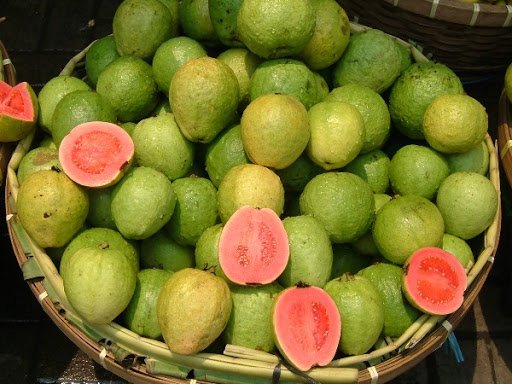Shape and appearance of guava fruit
The shape of a guava fruit is well-balanced and firm in hand. If it is not deformed, it means the guava is good, ripe and evenly ripe.
Choosing the guava is important by looking at the peel. A good guava usually has veins, slightly rough texture on the skin. If the skin feels rough, choose it because it has more flesh than seeds. If the guava skin is smooth, soft, lacks a firm sensation, it means that the guava flesh will be bland, less sweet, and not tasty.
Color of guava fruit
The best guava is ripe, still crispy, and retains its delicious sweet and sour taste. However, depending on individual tastes, you can definitely choose a guava that is ripe according to your preferences.
The ripe guava should have a light green color with a slight yellowish tinge, depending on the guava variety. But when choosing among adjacent guavas, you should choose the guava with ripe skin. Looking at the green skin, without any yellowish hue means it is not ripe enough to eat. The greener the guava, the more bitter it is, and the harder the flesh, making it difficult to eat.
For those who like a softer guava, they should choose a slightly riper fruit, meaning the skin will be darker yellow. Naturally ripe guava must have a uniformly yellow color, with a very bright and smooth appearance.

Weight and firmness of guava fruit
When buying guava, you should hold the fruit in your hand to determine its weight. Choose fruits that feel heavy and firm to touch so that the guava flesh will be juicy. If the guava fruit is light and slightly soft, it is not recommended to choose it, as it may be too ripe, too wilted, or losing water.
Press gently on the surface of the guava peel with your finger. If you feel a crisp and firm sensation, the guava will be fresh and tastier than the soft, wrinkled, and mushy ones.
Stem and leaves of guava fruit
If the guava still has a fresh stem, soft leaves, and not dried, it is freshly harvested. Newly harvested guava will still be fresh and contain more water than guava that has been harvested for a long time.
You should choose a guava that has flesh near the stem that has opened and slightly yellowed, as it will taste better. If the meat near the stem is still green and hard, it is not ripe guava.
Ripeness of guava fruit
The rind of the guava is the lowest part of the fruit, where traces of the calyx and stamens remain. The ripeness of the guava is proportional to the size of the calyx. The larger the hole, the riper the guava.
You can choose the ripeness threshold that is suitable for your taste. The smaller and tighter the guava calyx, the deeper the hollow, the greener the guava is, the more sour or bitter it will taste, and it will not be tasty.
Currently, guava is sold everywhere, and if not careful, you may mistakenly buy guava contaminated with harmful chemicals. To choose good and safe guavas, you should buy them from reputable places with quality assurance certificates or directly from the garden. This will increase your chances of choosing good guavas.






























